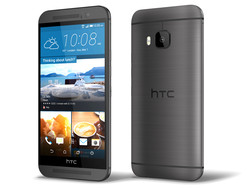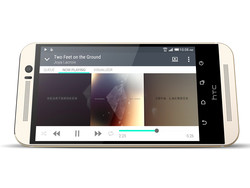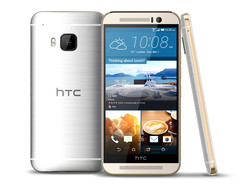Erster Eindruck: HTC One M9 im Test

Bevor in den kommenden Tagen der ausführliche Testbericht zum HTC One M9 folgt, wollen wir Ihnen unsere ersten Eindrücke schildern und mit Sie den ersten Testergebnissen versorgen. Der Vorgänger One M8 konnte im letzten Jahr bereits überzeugen und müsste sich lediglich Kritik aufgrund der schwachen Kamera gefallen lassen. Dies will HTC nun ändern und schickt eine neue 20-MP-Optik ins Rennen. Der flotte Qualcomm Snapdragon 810 soll dabei für rasante Performance sorgen und auch der etwas größere Akku verspricht eine gute Ausdauer.
Die Konkurrenz ist groß, muss im Vergleich aber noch mit den Vorjahres-Modellen antreten. Sowohl vom LG G3 als auch dem Samsung Galaxy S5 stehen die Nachfolger schon in den Startlöchern. Das Xperia Z3 und das OnePlus One runden die das Feld der Android-Konkurrenten ab. Das iPhone 6 und das Lumia 930 setzen auf iOS beziehungsweise Windows Phone.
Erster Eindruck
Rein äußerlich hat sich beim HTC One M9 kaum etwas geändert. Das Gehäuse besteht nach wie vor aus gebürstetem Aluminium und sieht nicht nur gut aus, sondern fühlt sich auch prima an. Es liegt zudem richtig gut in der Hand. Das Metall ist erstmals zweifarbig erhältlich. Laut den Taiwanern eine Weltpremiere.
Die Lautsprecher des Smartphones können immer noch überzeugen und gehören zu dem Besten, was man in einem mobilen Endgerät finden kann. HTC setzt sogar noch eins drauf und verspricht virtuellen Surround-Sound. Bei den Kommunikationsanbindungen gab es ebenfalls ein kleines Update. Bluetooth ist nun in Version 4.1 verfügbar und LTE in Cat. 6. Der Snapdragon 810 würde jedoch auch LTE Cat. 9 unterstützen.
Die im Vorfeld bekannt gewordenen Probleme mit der Oberflächentemperatur (wir berichten) hat HTC mit einem Update gut in den Griff bekommen.
Kameras
Die UltraPixel-Optik des One M8 wandert auf die Vorderseite des Smartphones, während auf der Rückseite sich nun eine Kamera befindet, die mit 20 MP reichlich Auflösung vorweisen kann. Im Vergleich zum M8 (4 MP) eine deutliche Verbesserung. Ob HTC endlich eine Top-Kamera gelungen ist, wird der ausführliche Test zeigen.
Die technischen Daten sind schon recht vielversprechend. Die Blende f/2.2 verspricht eine gute Lichtstärke, außerdem sind alle wichtige Funktionen wie Autofokus und HDR an Bord. Video können in Ultra HD aufgezeichnet werden.
Display
Das Display ist unverändert 5 Zoll groß und löst mit 1.920 x 1.080 Bildpunkten auf. Die daraus resultierende Pixeldichte von rund 441 PPI ermöglicht eine gestochen scharfe Darstellung des Inhaltes.
Das Kontrastverhältnis konnte HTC aufgrund des verbesserten Schwarzwertes nochmals verbessern. Leider ist die Gleichmäßigkeit der Ausleuchtung nur mäßig und auch die Farbraumabdeckung lässt zu wünschen übrig. Die Farbgenauigkeit weißt ebenfalls teils deutliche Abweichungen auf und bei den Graustufen wird der Blaustich besonders gut sichtbar.
| |||||||||||||||||||||||||
Ausleuchtung: 85 %
Helligkeit Akku: 474 cd/m²
Kontrast: 1185:1 (Schwarzwert: 0.4 cd/m²)
ΔE ColorChecker Calman: 6.32 | ∀{0.5-29.43 Ø4.78}
ΔE Greyscale Calman: 6.36 | ∀{0.09-98 Ø5}
58.81% AdobeRGB 1998 (Argyll 1.6.3 3D)
Gamma: 2.43
CCT: 8218 K
| HTC One M9 Adreno 430, 810 MSM8994, 32 GB eMMC Flash | HTC One M8 Adreno 330, 801 MSM8974AB, 16 GB iNAND Flash | Sony Xperia Z3 Adreno 330, 801 MSM8974AC, 16 GB eMMC Flash | Apple iPhone 6 PowerVR GX6450, A8, 128 GB eMMC Flash | Samsung Galaxy S5 Adreno 330, 801 MSM8974AC, 16 GB eMMC Flash | OnePlus One Adreno 330, 801 MSM8974AC, 64 GB eMMC Flash | |
|---|---|---|---|---|---|---|
| Bildschirm | -3% | -13% | 2% | -1% | -14% | |
| Helligkeit Bildmitte (cd/m²) | 474 | 474 0% | 702 48% | 520 10% | 358 -24% | 423 -11% |
| Brightness (cd/m²) | 458 | 486 6% | 671 47% | 511 12% | 364 -21% | 408 -11% |
| Brightness Distribution (%) | 85 | 93 9% | 90 6% | 88 4% | 82 -4% | 83 -2% |
| Schwarzwert * (cd/m²) | 0.4 | 0.54 -35% | 0.72 -80% | 0.61 -53% | 0.54 -35% | |
| Kontrast (:1) | 1185 | 878 -26% | 975 -18% | 852 -28% | 783 -34% | |
| Delta E Colorchecker * | 6.32 | 5.86 7% | 8.92 -41% | 3.92 38% | 5.28 16% | 5.56 12% |
| Delta E Graustufen * | 6.36 | 5.2 18% | 9.59 -51% | 4.33 32% | 4.65 27% | 7.55 -19% |
| Gamma | 2.43 91% | 2.29 96% | 2.75 80% | 2.46 89% | 2.48 89% | 2.33 94% |
| CCT | 8218 79% | 7218 90% | 9408 69% | 7384 88% | 7690 85% | 7624 85% |
| Farbraum (Prozent von AdobeRGB 1998) (%) | 58.81 |
* ... kleinere Werte sind besser
Leistung
Im HTC One M9 sorgt ein Snapdragon 810 MSM8994 für eine hohe Systemperformance. Der SoC ist das Nonplusultra, welches das kalifornische Unternehmen momentan zu bieten hat und einer der schnellsten Chips, die es auf dem Markt gibt. Lediglich der Tegra K1 und Samsungs Exynos 7420 können ihm Paroli bieten. Der Prozessor setzt sich aus insgesamt acht CPU-Kernen (4x Cortex-A57, 4x Cortex-A53) zusammen und taktet mit bis zu 2,0 GHz. 64-Bit wird ebenfalls unterstützt. Das installierte Google Android 5.0.2 Lollipop kann somit auf die vollen Ressourcen des SoCs zurückgreifen, welcher von 3 GB Arbeitsspeicher unterstützt wird. Für die Grafikberechnungen ist die integrierte Adreno 430 an Bord, welche bis zu 30 Prozent schneller sein soll als ihre Vorgängerin (Adreno 420).
In den Benchmarks liefert das HTC One M9 sehr gute Ergebnisse, doch wir hätten etwas mehr erwartet. Der A8-SoC von Apple ist manchmal etwas schneller, genauso wie Nvidias Tegra K1. Selbst der Vorgänger-SoC Snapdragon 805 liefert gelegentlich bessere Resultate. Die Gründe hierfür werden wir im ausführlichen Test näher beleuchten.
| AnTuTu v5 - Total Score (nach Ergebnis sortieren) | |
| HTC One M9 | |
| Apple iPhone 6 | |
| NVIDIA Shield Tablet P1761W | |
| Google Nexus 9 | |
| Google Nexus 6 | |
| Samsung Galaxy Note 4 | |
| OnePlus One | |
| 3DMark | |
| 1280x720 offscreen Ice Storm Unlimited Score (nach Ergebnis sortieren) | |
| HTC One M9 | |
| Apple iPhone 6 | |
| NVIDIA Shield Tablet P1761W | |
| Google Nexus 9 | |
| Google Nexus 6 | |
| Samsung Galaxy Note 4 | |
| OnePlus One | |
| HTC One M8 | |
| 1280x720 offscreen Ice Storm Unlimited Graphics Score (nach Ergebnis sortieren) | |
| HTC One M9 | |
| Apple iPhone 6 | |
| NVIDIA Shield Tablet P1761W | |
| Google Nexus 9 | |
| Google Nexus 6 | |
| Samsung Galaxy Note 4 | |
| OnePlus One | |
| HTC One M8 | |
| 1280x720 offscreen Ice Storm Unlimited Physics (nach Ergebnis sortieren) | |
| HTC One M9 | |
| Apple iPhone 6 | |
| NVIDIA Shield Tablet P1761W | |
| Google Nexus 9 | |
| Google Nexus 6 | |
| Samsung Galaxy Note 4 | |
| OnePlus One | |
| HTC One M8 | |
| GFXBench 3.0 | |
| on screen Manhattan Onscreen OGL (nach Ergebnis sortieren) | |
| HTC One M9 | |
| Apple iPhone 6 | |
| NVIDIA Shield Tablet P1761W | |
| Google Nexus 9 | |
| Google Nexus 6 | |
| Samsung Galaxy Note 4 | |
| OnePlus One | |
| HTC One M8 | |
| 1920x1080 1080p Manhattan Offscreen (nach Ergebnis sortieren) | |
| HTC One M9 | |
| Apple iPhone 6 | |
| NVIDIA Shield Tablet P1761W | |
| Google Nexus 9 | |
| Google Nexus 6 | |
| Samsung Galaxy Note 4 | |
| OnePlus One | |
| HTC One M8 | |
| Browsermark - 2.1 (nach Ergebnis sortieren) | |
| HTC One M9 | |
| Apple iPhone 6 | |
| Samsung Galaxy Note 4 | |
| OnePlus One | |
| Nokia Lumia 930 | |
| Octane V2 - Total Score (nach Ergebnis sortieren) | |
| HTC One M9 | |
| Apple iPhone 6 | |
| NVIDIA Shield Tablet P1761W | |
| Google Nexus 9 | |
| Google Nexus 6 | |
| Samsung Galaxy Note 4 | |
| Nokia Lumia 930 | |
| HTC One M8 | |
| Mozilla Kraken 1.1 - Total (nach Ergebnis sortieren) | |
| HTC One M9 | |
| Apple iPhone 6 | |
| NVIDIA Shield Tablet P1761W | |
| Google Nexus 9 | |
| Google Nexus 6 | |
| Samsung Galaxy Note 4 | |
| OnePlus One | |
| Nokia Lumia 930 | |
| HTC One M8 | |
* ... kleinere Werte sind besser
(+) Die maximale Temperatur auf der Oberseite ist 38.4 °C. Im Vergleich liegt der Klassendurchschnitt bei 35.2 °C (von 21.9 bis 247 °C für die Klasse Smartphone).
(+) Auf der Unterseite messen wir eine maximalen Wert von 36.1 °C (im Vergleich zum Durchschnitt von 34 °C).
(+) Ohne Last messen wir eine durchschnittliche Temperatur von 30.8 °C auf der Oberseite. Der Klassendurchschnitt erreicht 32.9 °C.
Energie und Akkulaufzeit
Die Leistungsaufnahme des HTC One M9 ist im ausgeschalteten Zustand um im Standby vorbildlich. Im Leerlauf liegt sie jedoch recht hoch. Das Samsung Galaxy S5 (0,3 -1,1 W) liefert deutlich bessere Ergebnisse. Trotz der hohen Performance fällt der Energiehunger unter Last jedoch recht gering aus, dennoch wird das Testgerät mit diesen Leistungsdaten keine neuen Bestwerte bei den Akku-Tests aufstellen können. Außerdem unterstützt das One M9 weder Fast Charge noch kabelloses Laden.
| Aus / Standby | |
| Idle | |
| Last |
|
Legende:
min: | |
Fazit
Wirklich revolutionäres hat das HTC One M9 leider nicht zu bieten, dennoch zeichnet sich ab, dass der Hersteller die bewährten Eigenschaften weiter versucht zu verbessern, während Kritikpunkte in Angriff genommen werden.
Haptik und Optik des One M9 bewegen sich auf einem hohen Niveau und werden dem Premium-Anspruch sicherlich gerecht. Die neue Kamera wird sich erst noch beweisen müssen und es wird ebenfalls spannend sein, ob HTC tatsächlich die legendäre Wärmeentwicklung des Snapdragon-Prozessors in den Griff bekommen hat.
Die spannendste Frage ist jedoch, ob die um 50 Euro erhöhte UVP gerechtfertigt ist. Zwar wird der Marktpreis sicherlich recht schnell fallen, dennoch bleibt hier für den Verbraucher ein fahler Beigeschmack. Den ausführlichen Testbericht lesen Sie in den kommenden Tagen.
Update: Der vollständige Test ist nun online.









